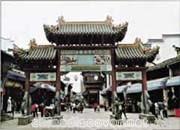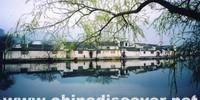
Tunxi is an ancient city with a long history. Early in the Qin and Han dynasties (more than 2200 years ago) a prefecture was set up. During the period of the Three Kingdoms, Mao Gan, a general of the state of Wu, once quartered his army in Tunxi. As for that the name Tunxi came into existence.
Tunxi, a beautiful mountain city, is situated by the side of Xin'an River. It is surrounded by green mountain with delighted of forests and graceful region of rivers and lakes, giving you poetic flavour. Of all ages many writers, poets, painters and photographers, reluctant to leave, have done many a piece of excellent works in praise of the mountain city.
Tunxi is a city newly-opened to tourist. It has area of 120 square kilometers and a population of 100000. There are many place of historical interest and men of letters here.
Pave with slab stone, the one-mile winding, and fascinating ancient street in the urban district is an ancient and bustling street well preserved in China. Shops on both sides of the street are built perfect order and antique style. As its buildings are after the fashion of the Song Dynasty, Tunxi is also called "Song City".
Ancient Resident House Visit
In Huangshan City, there are more than 4,000 residences built in the Ming and Qing dynasties. The majority of residences in southern Anhui Province are in traditional Chinese style: with gray-tiled tops, painted white walls, horse-headed eaves, and decorations of bamboo, wood, brick, and stone carvings.
Such residences can be mostly found in the counties of Yixian, Shexian, and Jixi. The most representative villages with such residences are Xidi and Hongcun in Yixian, Doushanjie in Shexian, Chengkan and Qiankou in the Huizhou District, and Fengcun and Shangzhuang in Jixi.
There are the Linjiang Park, Huangshan Park, Jiangxin Zhou Golden-Fish Park and other scenic spots in the city proper.27 kilometers to the east of the city, the town of Shexian (the old seat of Huizhou Prefecture) was set up in  the Qin Dynasty (about 2300 years ago). Since the Song Dynasty it has gradually become the "Home of Culture". Xin'an paint school, Xin'an medicine, Anhui engraving, brick and wood carving of Anhui school, Anhui Opera, Anhui cuisine and Anhui businessmen, to some degree, all had their place in China's history, hence the saying "It's not a town without Anhui stores".
the Qin Dynasty (about 2300 years ago). Since the Song Dynasty it has gradually become the "Home of Culture". Xin'an paint school, Xin'an medicine, Anhui engraving, brick and wood carving of Anhui school, Anhui Opera, Anhui cuisine and Anhui businessmen, to some degree, all had their place in China's history, hence the saying "It's not a town without Anhui stores".
Ancient Streets in Tunxi
The 832-meter-long Ancient Street in Tunxi was built in the Southern Song Dynasty. The street is lined on both sides with buildings in the Ming and Qing styles, and has become a commercial center. The buildings here are mainly brick and wooden structures topped by gray tiles, and decorated with woodcarvings.
At the back of most stores and shops are factories of residences. The towers are exquistite and elegant, with small doors, big-halls, small yards, and narrow lanes.
Place of historic interest include the Memorial Archway of Xuguo of the Ming Dynasty, Taibai Pavilion, Taiping Bridge, the East and south Watchtowers of the Song Dynasty, Pagoda of Changqing Temple, and Xinzhou Stonetower. After a bus drive of 33 kilometers, you can get to the beautiful Qiyun Mountain--the sacred Place of Taoism in China. Xu Xiake, a well-known traveller in the Ming Dynasty, had this remark:"the most mysterious scene in the Qiyun Mountain is the flying-down waterfall." Qianlong, emperor of the Qing Dynasty, described it as "None are equal to the mountain which is the greatest in South Anhui."
The located products include the famous tea such as "Tunlu", "Qihong", "Houkui", "Huangshan Maofeng", and Huizhou's inkstick, Shexian's inkslab (two of the "four treasures of the study" in China), and lacquer-ware, bamboo weaving, and etc.
With pleasant weather, Tunxi is suitable for tourism all the year round. It is an ideal scenic spot and the only way to the marvellous Huangshan Mountain as well.
